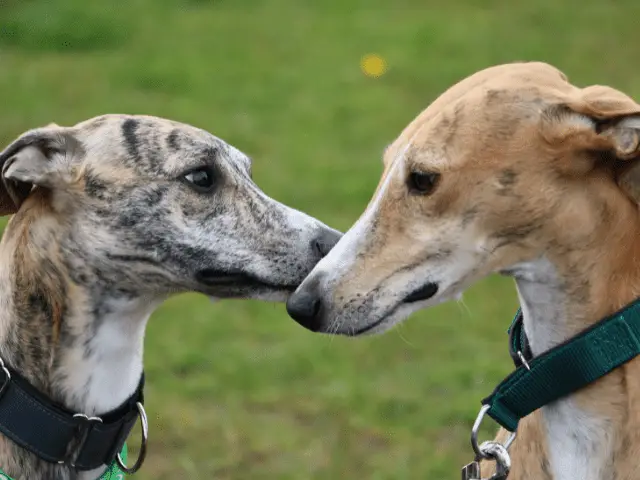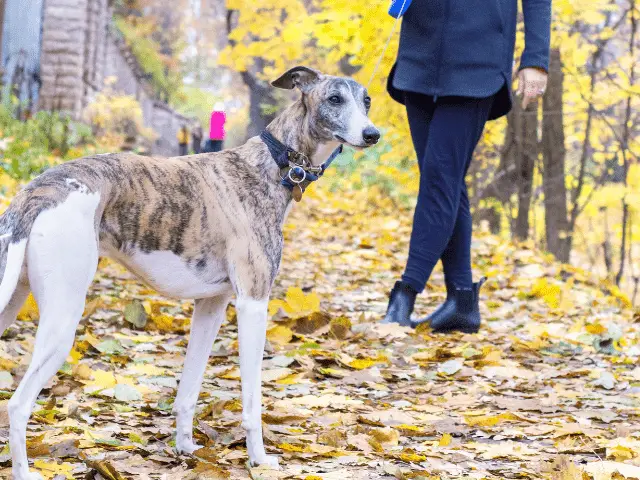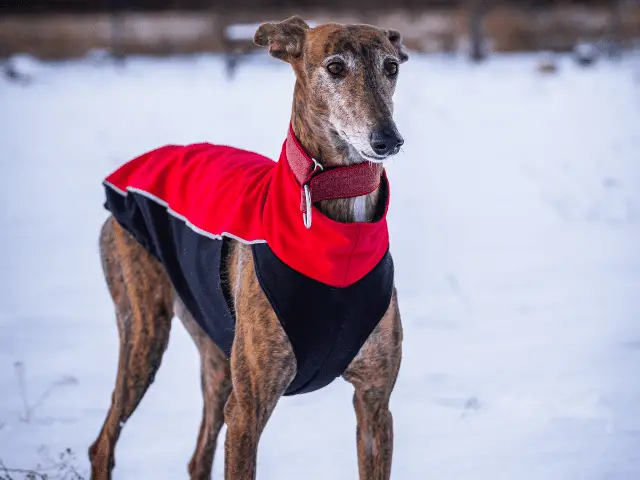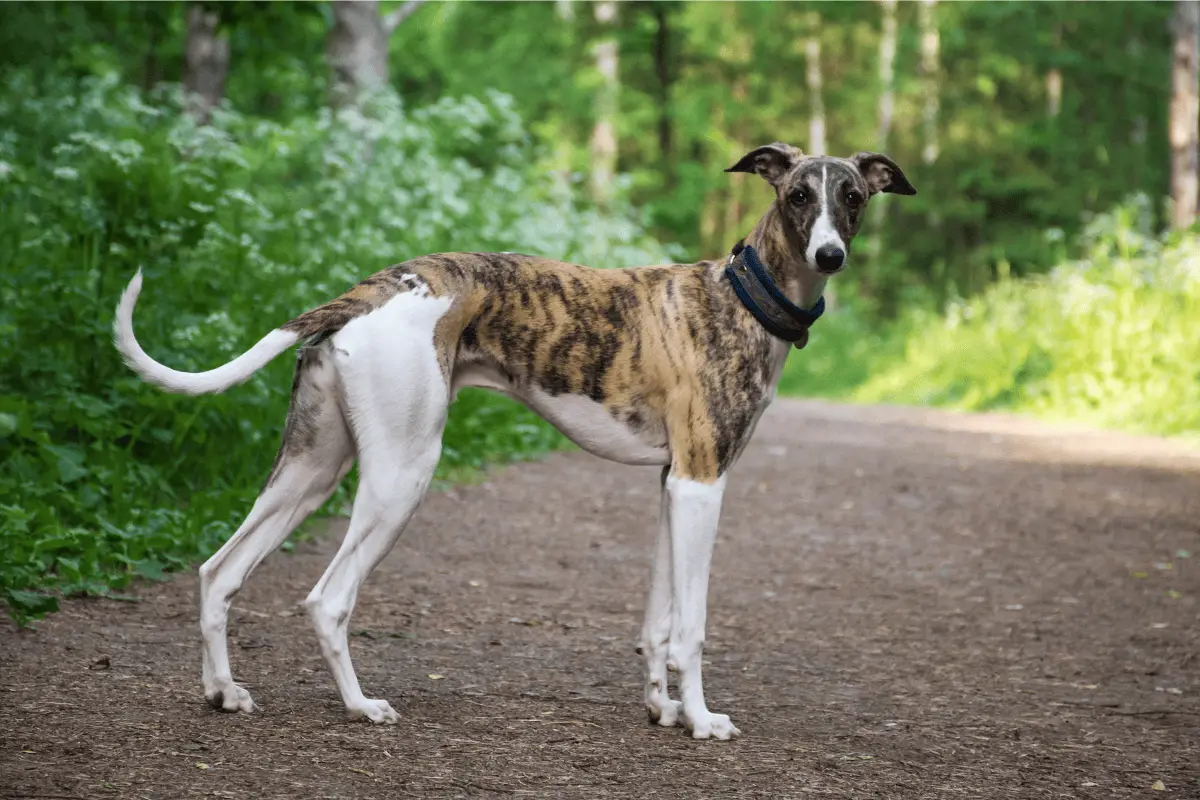The greyhound breed was designed for running, and they have been used in coursing, racing, and other endurance sports for centuries, if not millennia.
Greyhounds are an incredibly old breed, with the oldest suspected greyhound remains estimated as being 4,000 years old and some recovered remains which are genetically identical to modern greyhounds being at least 1,100 years old.
They have been bred by human societies across Asia and Europe for thousands of years and are designed to have a very specific appearance and physical ability. As you would imagine, these thousands of years of selective breeding have created a dog that is quite unique in many ways.
This article contains affiliate links. If you make a purchase through one I may receive a commission.
Greyhounds Physical Traits
They are tall, muscular, and deep-chested, with a distinctive “S-shaped” body. Their powerfully strong legs, flexible back, and aerodynamic build allow them to reach impressive speeds, which plays significantly into their talents as racing dogs.
Greyhounds are a long nosed dog . Their bodies and faces are narrow and relatively long compared to their width, and their racing or other sporting speeds regularly exceed 40mph.
. Their bodies and faces are narrow and relatively long compared to their width, and their racing or other sporting speeds regularly exceed 40mph.
Their history of participating in sports with other dogs and human handlers has also led them to be friendly and sociable. Greyhounds get along well with people, other dogs of similar size, and sometimes smaller animals like cats and miniature-breed dogs, which makes them potentially good pets for almost any type of household.
They are gentle, typically quiet, and friendly dogs, and to many, they are the ideal companion.
However, there are some questions that also naturally arise when adopting or caring for a greyhound; how do they handle slower-paced activities like hiking, when they are used to racing or participating in running sports? How are they different from other breeds, especially with regard to physical ability and temperament?
And what can you do, as your human companion, to prepare them for their new life and new activities?
Are Greyhounds Good Hiking Companions?

We tend to think of greyhounds as very active dogs, and particularly if you adopt a retired racing greyhound (which is an increasingly popular way of finding a greyhound companion), you may expect them to be able to keep up with you no matter what the activity.
The reality is that sprinting at 45mph for two minutes or less is very different from walking or hiking at 2mph for multiple hours. Greyhounds are naturally built for power and speed, not for endurance, and their baseline level of stamina may be quite low, especially if their only activities prior to entering your home were racing and training for races.
This isn’t to say that greyhounds aren’t able to accompany you on hikes — in fact, over time, they can become great hiking companions.
They are sociable and loving pets, and they love to spend time with their human family, so they will be eager to hike simply because it means more quality time with you. They also like to be outdoors and have the chance to explore, and like all dogs, they need a certain amount of exercise every day, so hiking can be a great option.
The main thing to know is that hiking with a greyhound may be different from hiking with other breeds, because greyhounds are different in so many ways. They can enjoy hiking just as much as any other dog, and hiking can be just as physically and mentally beneficial for them as it is for more natural hiking breeds, but you must approach it differently.
This means knowing your dog well, finding the right hiking conditions for them, and preparing appropriately for your hikes with them.
Know Your Greyhound

There are many things that can be said about greyhounds as a whole, but their individual history and personality will be more important than general breed characteristics when preparing to take them hiking.
Your own experience with and knowledge of your dog will be more important than anything that Wikipedia or the AKC can tell you about greyhounds as a breed.
One obvious thing to consider is the age of the dog. Young puppies should generally not be taken on hikes, as activities like hiking can affect their growth and physical development; on the other hand, older dogs may not have the endurance or joint stability for long or rigorous hikes.
Greyhounds are a generally healthy breed, but because the life of a racing dog can be extremely taxing, especially if the handler is negligent or ignorant of proper racing greyhound care practices, rescued greyhounds may have other complications.
Their past lives as racing dogs can show in everything from their joint health to their level of anxiety in response to loud noises. If your rescue pup has any injuries, health conditions, or obvious stressors related to their racing or sporting career, you may need to modify your hikes or help them to train, physically or mentally, to be better prepared.
The personality of your greyhound is also something that will affect their ability to be a good hiking companion.
Although we think of them as being active, because they were really bred for short bursts of intense activity, many greyhounds prefer to be couch potatoes the majority of the time.
This can be great if you have a small home or no yard to exercise them in, as they will be perfectly happy to lounge around the house with you, but it can be difficult to motivate more “potato-inclined” greyhounds to embark on a hike with you. They may need more training and more encouragement than a hyperactive breed that is ready for an adventure at the drop of a hat.
Know the Hiking Conditions

Despite their impressive musculature, powerful builds, and tough paws, greyhounds are not the most sturdy of breeds. If you really study a greyhound, you will see that they are almost entirely muscle and bone; they have almost no fat, very thin skin, and a short, sparse coat of hair. As a result, they cannot tolerate extreme temperatures or harsh weather conditions.
In heat or harsh sunlight, your greyhound should always have access to water and as much shade as possible, and they may be able to hike only a very short distance, if at all. Their skin is thin, pale, and not protected by their thin coat, so they are one of the breeds most susceptible to sunburn.
Just like you, they should be protected from sun exposure with breathable clothes that offer lots of coverage or even with sunscreen (yes, there is sunscreen for dogs!).
In cold weather, your greyhound should wear a coat or other warm clothing unless they are only going outside for a few short moments, such as into the backyard to use the bathroom. If you are considering hiking with your greyhound in cold weather, make sure they have enough clothing to keep them warm and, in rainy or snowy conditions, dry.
Water will quickly reach a greyhound’s skin and make them feel very cold in winter weather, so they should be covered as much as possible in order to prevent this. As long as the appropriate precautions are taken and they have a warm, dry place indoors to rest afterwards, they should be quite comfortable.
Plan Ahead for Your Hike
Most breeds, even the best hiking breeds, need to build up to longer hikes to be able to truly enjoy them. This is certainly true of greyhounds, who are not naturally inclined towards endurance activities like hiking.
The good thing is, greyhounds are physically and mentally adaptable, as they have to be able to learn and train in order to be good athletes. You can have your greyhound condition their stamina and practice hiking gradually in order to build up their tolerance to the activity.
Depending on their level of activity and endurance when you adopt them, you may need to start with regular, short walks and add distance, elevation, and other variables as they build their stamina.
Greyhounds don’t need as much obedience training as some other breeds in order to be polite hiking dogs, but there are still commands they should know. Most of them are friendly with all people, even strangers, and they don’t tend to bark much, so they should have no issue with the others you may encounter on your hikes.
However, they do have a bit of a prey drive, so they may get distracted by or even try to chase after the smaller animals that are likely to be present on whatever trail you choose.
Training your greyhound to ignore distractions, to “leave it” when they see prey animals, or to return their attention to you on command will help with this drive and make sure they are listening to you and taking your lead on the hike.
As they learn these commands and improve their off-leash recall in controlled environments like a fenced yard, you may even feel comfortable hiking them without a leash or tether.
No matter what you choose to do, as long as you have the right equipment and knowledge to help your pup stay safe and comfortable, they will happily be your hiking companion for many years to come.
Have More Dogs In Your Pack?
Find this guide helpful? We have guides for other breeds as well written by dog owners and vet experts. If you have another dog in your pack like a Golden Retriever or German Shorthaired Pointer, these guides can be just as helpful!

